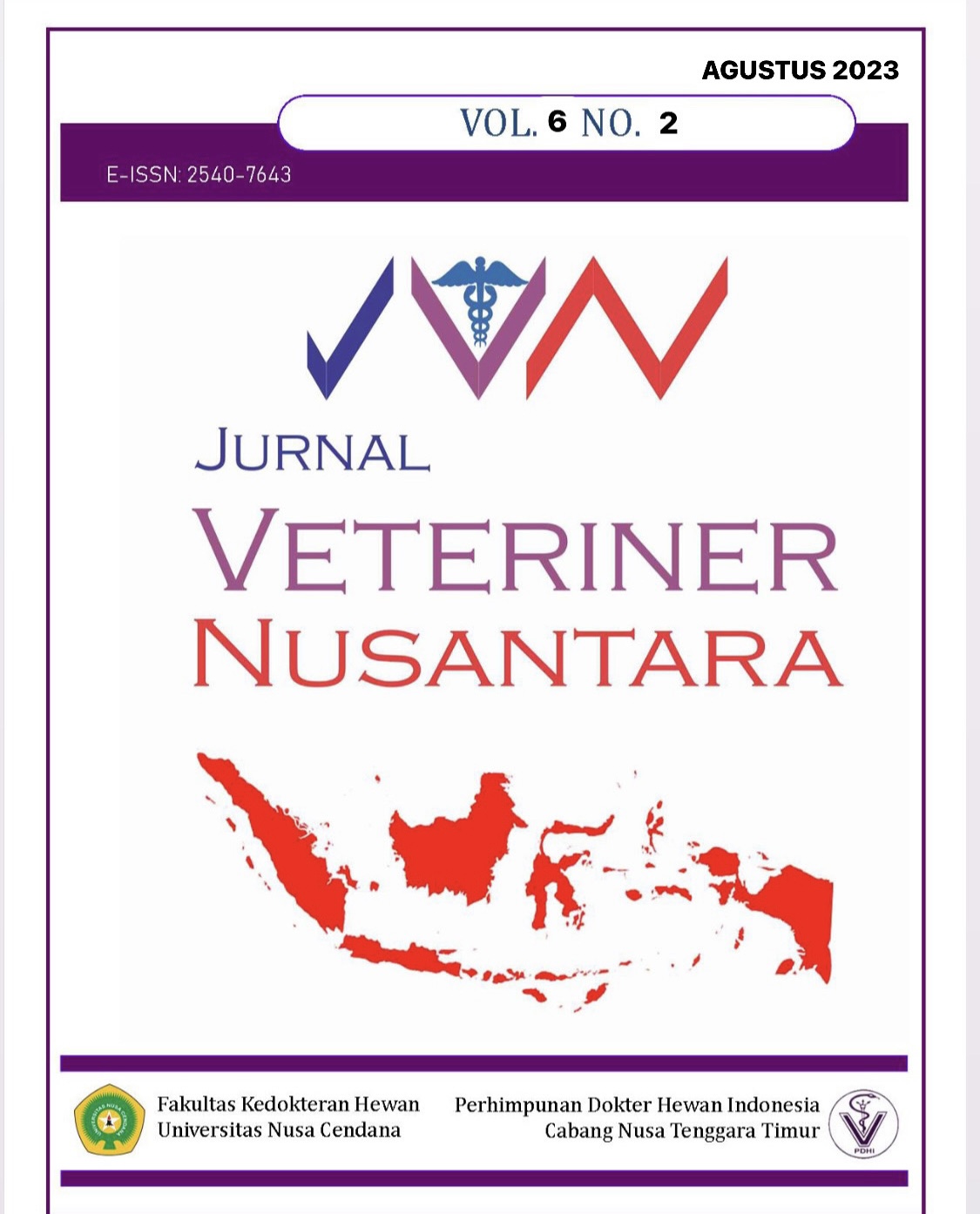Skrining Fasciolosis Pada Hewan Qurban Di Palangka Raya
Abstract
Fasciola sp. a parasite which impacts ruminants including cattle, cause of the zoonotic disease fascioliosis. This study aims to describe the fasciolosis parasite in sacrificial animals on the Palangka Raya University campus in July–August 2023. This research is a descriptive exploratory study by examining the feces and livers of 15 samples of sacrificial animals with native methode. The results of the diagnosis of fasciolosis are based on the presence of Fasciola sp. eggs in the feces of sacrificed animals and the discovery of the parasite Fasciola sp. in the liver during post-mortem examination. The development of liver lesions in the form of inflammation and calcification brought on by the existence of Fasciola sp. was a defining characteristic of positively infected liver samples by worm infestations. Fasciola sp. eggs were found in the fecal samples with ovoid morphological characteristics, having an operculum at one pole, thin and smooth walls, and yellowish brown. The presence of Fasciola sp. being influenced by environmental factors, it is also heavily influenced by management factors, the majority of breeders in Palangka Raya take grass in watery areas where there are snails as intermediate hosts. This information can be a recommendation to the livestock service and to breeders to provide feed that is free of hosts and metacercariae of Fasciola sp. in Palangka Raya City.
Downloads
References
Balqis, Ummu., Darmawi, S. Aisyah, M. Hambal. 2013. Agripet. 13 (1): 53-58.
Choidini,P.L., Moody,A.H., Mansher, D.W. Medical Helminthology and Protozoology. 2001. New York: Churchil livingstone.
Haryanto, Bambang., F.F. Munir dan Wardi. 2019. Prevalensi Parasit Cacing pada Organ Pencernaan Sapi Potong pada Lahan Kering dan Basah di Kalimantan Tengah. Seminar Nasional Peternakan Tropis Berkelanjutan UNS Fakultas Pertanian – Universitas Sebelas Maret “Pengembangan Peternakan Indonesia Pasca Pandemi COVID 19”.
Kurniabudhi. (2014). Prevalensi Kejadian Infeksi Cacing Hati (Fasciola sp) Pada Sapi Potong di Rumah Potong Pegirian Surabaya Tahun 2014. Artikel Ilmiah. LPPM Universitas Wijaya Kusuma. Surabaya.
Moore, D. A. J., Morris-Jones, S., & Nabarro, L. (2019). Peters’ Atlas of Tropical Medicine and Parasitology. Elsevier.
Nyindo, M. and Lukambagire, A.-H. (2015) ‘Fascioliasis: An ongoing zoonotic trematode infection’, BioMed Research International, 2015, pp. 1–8. doi:10.1155/2015/786195.
Paniker, CK Jayakram. 2013. Medical Parasitology. Nepal:Jaypee Brother Medical Publishers.
Pouder, D B., E.W. Curtis dan R.P.E. Yanong. 2012. Common Freshwater Fish Parasites Pictorial Guide. The Insitute of Food and Agricultural Sciences (IFAS), University of Florida
Prianto, Juni., Tjahaya.P.U., Darwanto. 2006. Atlas Parasilotogi Kedokteran. Gramedia Pustaka. Jakarta.
Purnowo, E. (2019). Gambaran Kasus Fasciolosis (Cacing Hati) Pada Sapi Bali Berdasarkan Data Hasil Pemeriksaan Hewan Qurban Di Kabupaten Manokwari Tahun 2018. Jurnal Triton, 10(1).
Purwaningsih, P., Noviyanti, N., & Putra, R. P. (2018). Distribusi Dan Faktor Risiko Fasciolosis Pada Sapi bali di distrik prafi, Kabupaten Manokwari, Provinsi Papua barat. Acta VETERINARIA Indonesiana, 5(2), 120–126. https://doi.org/10.29244/avi.5.2.120-126.
Rai, S.K., S,Uga., N.Kataoka., dan T. Matsumura. 1996. Atlas of Medical Parasitology, : Kyokuseisya Co.,Ltd., Japan.
S. Welburn, I. Beange, M. Ducrotoy, and A. Okello. (2015). “The neglected zoonoses—the case for integrated control and advocacy,” Clinical Microbiology and Infection, vol. 21, no. 5, pp. 433–443.
Yuliani, Andar., & Suyatmi. (2021). Kejadian fasciolosis pada Hewan Qurban 1442 H/2021 di Kabupaten Blitar. – Dinas Peternakan dan Perikanan. (2021, October 27). https://disnakkan.blitarkab.go.id/2021/10/27/kejadian-fasciolosis-pada-hewan-qurban-1442-h-2021-di-kabupaten-blitar/
Wibisono, F. J., & Solfaine, R. (n.d.). (2015). Insiden Hewan Qurban Sebagai Vektor Penular Penyakit Cacing Hati (Fasciolosis) di Surabaya. Jurnal Kajian Veteriner, 3(2). 139-146
Zulkarnain, D., Aku, A. S., Rahmatullah, R., & Munadi, L. M. (2021). Prevalensi Cacing Fasciola Hepatica Pada Sapi akseptor program Upsus Siwab di Kabupaten muna. Journal of Livestock and Animal Health, 4(1), 1–6. https://doi.org/10.32530/jlah.v4i1.291
Copyright (c) 2023 Meyta Wulandari, Febri Nur Ngazizah, Rizka Hasanah

This work is licensed under a Creative Commons Attribution-ShareAlike 4.0 International License.

 Febri Nur Ngazizah(1)
Febri Nur Ngazizah(1)



 Visit Our G Scholar Profile
Visit Our G Scholar Profile




